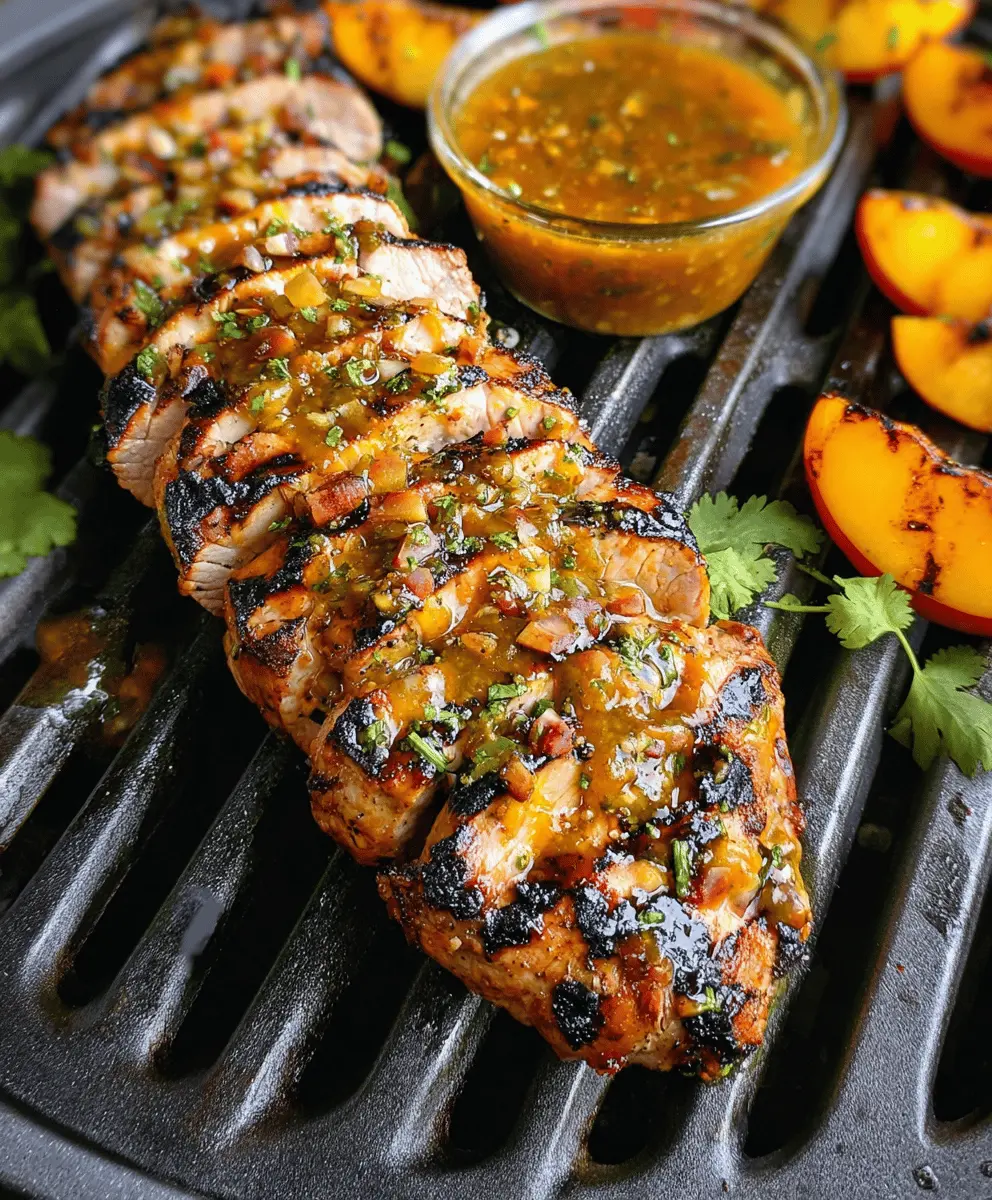This Easy Peach Grilled Pork Tenderloin is a perfect summer dish! The juicy pork pairs wonderfully with sweet peaches for a mouthwatering flavor that’s hard to resist.
Grilling brings out the best in both the pork and the fruit! I love how quickly it comes together—throw it on the grill and enjoy. Dinner is served and the family is happy! 😊
Key Ingredients & Substitutions
Pork Tenderloin: This cut is lean and tender, making it perfect for grilling. If you’re looking for a leaner option, you could substitute with chicken breast or turkey tenderloin, but adjust cooking times accordingly.
Peaches: Fresh, ripe peaches bring the best flavor. If peaches are out of season, you can use canned peaches (drain them well) or apricots as a substitute. Remember, seasonal fruit always tastes better!
Peach Preserves: These add sweetness and a sticky texture to your glaze. If you don’t have preserves, try using honey or maple syrup as an alternative for that touch of sweetness.
Orange Juice: Freshly squeezed juice is always my go-to for the best flavor. If you don’t have any on hand, bottled orange juice will work, but it won’t have the same freshness.
How Do I Achieve the Perfect Marinade for My Pork?
The marinade is key for flavor, and here’s how to nail it! Combine your ingredients well so the flavors meld together. Marinating for at least an hour allows the pork to absorb the flavors, but longer means more flavor. Here’s a quick breakdown:
- Use a resealable bag or dish for even coating.
- Make sure the pork is fully covered in glaze; flip it halfway through if you can.
- Always reserve some glaze for later to brush on the pork while grilling.
Just remember, never reuse marinade that’s touched raw meat without cooking it first!
What’s the Best Way to Grill Pork Tenderloin?
Grilling pork tenderloin can seem daunting, but it’s actually quite simple! Here’s how to do it right:
- Preheat your grill well! Aim for medium-high heat (around 400°F/200°C) to get that nice sear.
- Oil the grates to prevent sticking—this is super important!
- Cook the tenderloin until it reaches an internal temperature of 145°F (63°C). Use a meat thermometer for accurate results.
- Let the meat rest for 5 minutes after grilling. This helps the juices redistribute, keeping it moist.
By following these tips, your pork will come out beautifully cooked and packed with flavor! Enjoy your meal! 🍑🍖

Easy Peach Grilled Pork Tenderloin
Ingredients You’ll Need:
- 1 1/2 to 2 pounds pork tenderloin, trimmed
- 2 ripe peaches, peeled, pitted, and chopped
- 1/2 cup peach preserves or peach jam
- 1/4 cup orange juice (freshly squeezed recommended)
- 1 lime, juiced
- 1/4 cup chopped red onion
- 2 cloves garlic, minced
- 1 tablespoon olive oil
- 1 tablespoon soy sauce
- 1 teaspoon ground cumin
- 1/2 teaspoon smoked paprika
- Salt and freshly ground black pepper, to taste
- Fresh cilantro, chopped (for garnish)
- Orange and lime wedges (for serving)
How Much Time Will You Need?
This Easy Peach Grilled Pork Tenderloin recipe will take about 20 minutes of active cooking time, plus at least 1 hour for marinating (up to 4 hours for more flavor). So, plan for about 1 hour and 20 minutes total before you serve it up—perfect for a summer meal on the grill!
Step-by-Step Instructions:
1. Make the Peach Glaze:
In a blender or food processor, combine the chopped peaches, peach preserves, orange juice, lime juice, red onion, garlic, olive oil, soy sauce, cumin, and smoked paprika. Blend or process until smooth. Taste the glaze and adjust with salt and pepper as needed. This delicious mix is what will give the pork a sweet and tangy flavor.
2. Marinate the Pork:
Place the pork tenderloin in a large resealable plastic bag or shallow dish. Pour half of the peach glaze over the pork and make sure it’s well coated. Reserve the rest of the glaze for later use. Seal the bag tightly or cover the dish and let it marinate in the refrigerator for at least 1 hour. If you can wait, marinate for up to 4 hours for an even richer flavor.
3. Preheat the Grill:
While your pork is marinating, preheat your grill to medium-high heat, which is about 400°F (200°C). Don’t forget to oil the grill grates to prevent the pork from sticking!
4. Grill the Pork:
After marinating, remove the pork tenderloin from the marinade, allowing any excess glaze to drip off. Place it directly onto the hot grill. Cook the pork, turning occasionally and basting with the reserved peach glaze, until it reaches an internal temperature of 145°F (63°C). This should take about 15-20 minutes, depending on the thickness of the tenderloin.
5. Let It Rest:
Once the pork is cooked, take it off the grill and let it rest for about 5 minutes. This resting period helps keep it juicy and tender!
6. Slice and Serve:
Slice the pork tenderloin into medallions. Drizzle any leftover peach glaze over the top and sprinkle with freshly chopped cilantro for a burst of flavor. Serve with orange and lime wedges on the side for a refreshing touch.
Enjoy your juicy, flavorful Easy Peach Grilled Pork Tenderloin! This dish is sure to be a hit at your next gathering—it’s sweet, tangy, and oh-so satisfying!

FAQ for Easy Peach Grilled Pork Tenderloin
Can I Use Chicken Instead of Pork Tenderloin?
Absolutely! Chicken breast or thighs can be used as a substitute. Keep in mind that chicken should be cooked to an internal temperature of 165°F (74°C) and may require a slightly longer cooking time depending on the thickness.
How Do I Store Leftover Pork Tenderloin?
Store any leftovers in an airtight container in the refrigerator for up to 3 days. To reheat, gently warm it in the microwave or on the stove over low heat to avoid drying it out. You can also slice it cold for salads or sandwiches!
Can I Freeze the Marinated Pork?
Yes, you can freeze the marinated pork tenderloin! Place the pork and marinade in a resealable freezer bag and remove as much air as possible. It can be frozen for up to 3 months. When you’re ready to cook it, thaw it in the refrigerator overnight before grilling.
What Other Fruits Can I Use for the Glaze?
If peaches aren’t available, you can easily swap them for other fruits like nectarines, apricots, or even pineapples. Just adjust the sweetness and acidity balance according to the fruit you choose. Experimenting can lead to some delicious discoveries!


